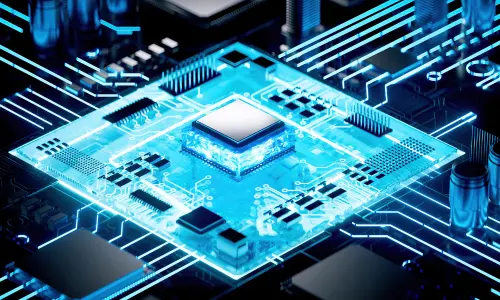What is a Graphics Processing Units & Its Importance for AI

Why Modernizing Legacy Systems Matters for Enterprises
June 9, 2025
Google Add Markup Support for Loyalty Programs
June 11, 2025The world of technology is constantly evolving, and at the heart of many of these advancements, especially in the realm of artificial intelligence, lies a powerful component known as the Graphics Processing Unit. While traditionally associated with rendering stunning visuals in video games, the Graphics Processing Units have become an indispensable tool for tackling the complex computational demands of modern AI. Understanding what a GPU is and why it’s so crucial for AI can shed light on the rapid progress we’re witnessing in fields like machine learning, deep learning, and data science.
Understanding the Graphics Processing Unit (GPU)
At its core, a Graphics Processing Unit is a specialized electronic circuit designed to rapidly manipulate and alter memory to accelerate the creation of images in a frame buffer intended for output to a display device. This might sound like a technical definition, but its fundamental strength lies in its architecture. Unlike a Central Processing Unit (CPU), which excels at handling a wide range of tasks sequentially, a GPU is built with thousands of smaller, more specialized cores. These cores are designed to perform a massive number of simple calculations simultaneously. This parallel processing capability is what makes the Graphics Processing Unit so uniquely suited for certain types of computational problems.
How a GPU Differs from a CPU
To truly grasp the power of a GPU, it’s helpful to compare it to its more general-purpose counterpart, the CPU. Think of a CPU as a highly intelligent manager who can handle many different types of tasks, but one at a time. It’s excellent at complex decision-making, task switching, and managing the overall operations of a computer.
In contrast, a GPU is like a massive workforce of specialized laborers. Each laborer can only do one simple thing (e.g., a mathematical calculation), but there are thousands of them, all working in parallel. If you have a task that can be broken down into thousands of independent, identical sub-tasks, the GPU will complete it significantly faster than a CPU. This fundamental difference in architecture is the key to the GPU’s dominance in AI.
The Rise of GPUs in Artificial Intelligence
For a long time, CPUs were the primary workhorses for most computing tasks, including early attempts at AI. However, as AI models grew in complexity, particularly with the advent of deep learning, the limitations of CPUs became apparent. Training deep neural networks involves performing millions, if not billions, of matrix multiplications and other linear algebra operations. These are precisely the types of calculations that can be parallelized effectively.
Deep Learning and Parallel Processing
Deep learning, a subfield of machine learning, relies on artificial neural networks with multiple layers to learn from vast amounts of data. Training these networks involves an iterative process of feeding data, calculating errors, and adjusting the network’s internal parameters (weights and biases). Each of these adjustments often requires thousands of identical calculations.
This is where the Graphics Processing Unit truly shines. Its parallel architecture allows it to perform these calculations simultaneously across its numerous cores. Instead of processing one piece of data at a time, a GPU can process hundreds or even thousands of data points concurrently, dramatically reducing the time it takes to train a deep learning model. This acceleration has been a pivotal factor in the rapid advancements seen in areas like image recognition, natural language processing, and speech synthesis.
Data Science and Big Data Analytics
Beyond deep learning, the importance of the Graphics Processing Unit extends to the broader field of data science and big data analytics. Many data science tasks, such as data cleaning, feature engineering, and running complex statistical models, involve operations that can benefit from parallel computation. For instance, processing large datasets to identify patterns or anomalies often requires repetitive calculations across numerous data points. GPUs can significantly speed up these processes, allowing data scientists to iterate more quickly and explore more complex models.
Furthermore, with the increasing volume and velocity of data, the ability to process information efficiently has become paramount. GPUs offer a powerful solution for accelerating data processing pipelines, enabling real-time analytics and faster insights from massive datasets.
The Future of AI and GPU Integration
The symbiotic relationship between AI and the Graphics Processing Unit is only growing stronger. As AI models become even more sophisticated and data continues to proliferate, the demand for more powerful and efficient GPUs will intensify. GPU manufacturers are constantly innovating, developing new architectures and technologies specifically tailored for AI workloads.
Specialized AI Accelerators
While traditional GPUs are already highly effective for AI, the industry is also seeing the emergence of specialized AI accelerators. These are chips designed from the ground up to optimize for specific AI computations, often incorporating custom instruction sets and memory architectures. While not strictly a Graphics Processing Unit, these accelerators draw heavily from the principles of parallel processing pioneered by GPUs, further blurring the lines and pushing the boundaries of what’s possible in AI.
Edge AI and Low-Power GPUs
Another significant trend is the rise of “edge AI,” where AI computations are performed directly on devices (like smartphones, smart cameras, or IoT sensors) rather than in the cloud. This requires low-power, highly efficient GPUs or AI accelerators that can deliver significant computational power within a limited power budget. The development of such embedded Graphics Processing Units is crucial for enabling a new generation of intelligent devices and applications.
The Graphics Processing Unit, once primarily a visual rendering powerhouse, has transformed into the backbone of modern artificial intelligence. Its unique parallel processing architecture makes it exceptionally well-suited for the computationally intensive demands of deep learning, machine learning, and big data analytics. As AI continues to evolve and permeate every aspect of our lives, the importance of the Graphics Processing Unit will only grow, driving innovation and enabling breakthroughs that were once unimaginable. From powering self-driving cars to understanding human language, the GPU is an indispensable component in shaping the intelligent future.


